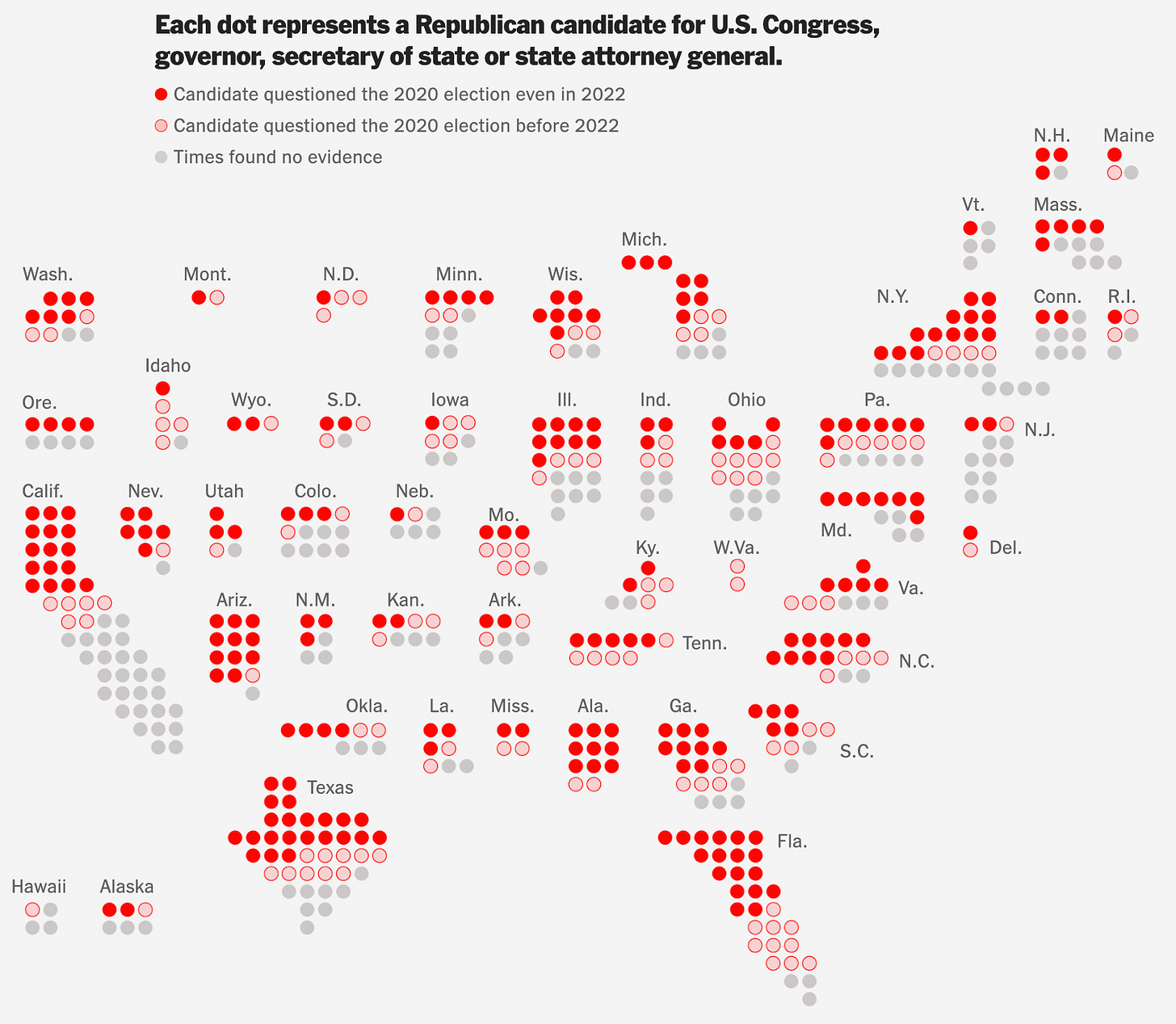Destabilized Saturday Edition #39
Whistling past democracy's graveyard, "let's get right to the violence", Pink's keen eye for character, the disappearing male psychologist, 2022 dating app profile update

Ed. note: I will return to climate change soon – I have a post in the works about what the interactions among insurance, markets, and politics mean for the climate transformation, individual and family ruggedization, and wealth preservation.
—
There’s a massive disconnect right now between the stakes of this election and the tone of most political coverage. It can be seen clearly in the gap between two articles I read today. First, a piece in the New York Times about the Republicans running for U.S. House and Senate at the federal level, and governor, secretary of state, and attorney general at the state level.
More than 370 people — a vast majority of Republicans running for these offices in November — have questioned and, at times, outright denied the results of the 2020 election despite overwhelming evidence to the contrary.
…Far from fading over time, as many Americans had hoped, election lies and misinformation have proved strikingly resilient, even amid a political campaign season in which far more is being said by candidates and their party officials about issues like inflation and abortion. The Times has for the first time identified more than 240 candidates who are still casting doubt on the presidential election this year — many of them within the last couple of months.
We can see in their graphic (top image of this post) that these Republican election deniers are a supermajority of all Republicans running for these powerful offices.
It’s good the Times is covering and documenting this radicalism, but the way they bucket the various politicians implicitly frames election denial as the act of making statements that echo and support a false belief. As fascism scholar Ruth Ben-Ghiat points out, however, election denial is more serious and destructive than a mere belief.


It’s very bad! There are obviously those who recognize its seriousness; if there weren’t, the NYT article wouldn’t have been assigned, exhaustively researched, and written. But we also see tons of mainstream election coverage and analysis where the everything-is-normal tone is more consistent with Obama and McCain debating tax rates than with a rising fascist movement on the cusp of winning key nodes of power.
Here’s Nate Silver, probably the most important election analyst in the country, writing today about the state of the 2022 election and the relative merits of different tools in evaluating it:
The other weakness in these prediction markets is that the traders don’t have a lot of technical sophistication about election forecasting. That’s not to say they aren’t sophisticated in general. Traders may know a lot about politics, they may have a good sense for market psychology, and they may be smart people who are good general-purpose estimators. But there are some questions for which actually going through the process of building a model helps a lot, such as in determining how much an election forecast should shift in response to a modest but noisy shift in the polls.
Which… okay. Why not, right?
Nate concludes his piece with this:
It’s probably bad for FiveThirtyEight site traffic to say this, but the final few weeks of the midterm campaign may not be all that climactic or action-packed. Certainly, a lot of the individual races are quite fascinating, but “October surprises” that affect one race may not affect others. There may be some changes in the big-picture, topline numbers, but probably not huge ones. And that means we’ll enter Election Day with a lot of uncertainty about which party will emerge with control of Congress.
Though individual races are “fascinating,” he says, in general things will tend to be more steady-state than “action-packed” in the final weeks. Nary a word about the existential stakes for American democracy in these elections. One can argue this is appropriate. After all, Nate’s profession is data analysis and election forecasting; it’s not his job to warn people about encroaching authoritarianism, this argument goes, and he has no particular qualifications to do so.
But that’s exactly the problem: it’s almost nobody’s job. Since much of our good fortune as Americans is built on top of democracy and rule-of-law, it should be every teacher, business owner, nonprofit executive, journalist, election analyst, discontinuity resilience strategist, lawyer, and civic leader’s job to sound the alarm and explain what’s happening and what the stakes are. But relatively few seem to see it that way and the net result is a simulacrum of normalcy, which creates the misimpression that things are generally fine.

To go a bit deeper on the nature of this problem, think back to March 11, 2020, the night the NBA canceled games right before tipoff after then-Utah Jazz center Rudy Gobert tested positive for covid. People paying close attention had known for weeks that COVID19 was going to be bad, but until March 11th the U.S. had mostly kept chugging along as if everything was fine. But when a for-profit institution like the NBA started voluntarily canceling its own games? It was a powerful signal to lots of people that something out of the ordinary was going on.
This kind of action-based signal matters because people consume information and learn about the world mainly by “scanning” the landscape passively rather than processing with an active and skeptical mind. Nobel Prize winner and father of behavioral economics, Dan Kahneman, describes humans, himself included, as cognitively “lazy,” in that we will only engage in focused mental effort when we have to. As we scan, we use heuristics (rules-of-thumb) to monitor for dangers, adjust our conduct if needed, and decide whether and when we need to focus. One of those heuristics is that when there’s a real emergency or crisis people act like it. That means if those we pay attention to and notice are acting normally we can assume things are more or less fine. Based on that assumption, we will carry on as usual.


This kind of day-to-day “social proof” has an incredibly powerful influence on human behavior. Let’s hope there are enough of the right political signals being sent below pollsters’ radar that we are actually approaching a pro-democracy mini-wave election rather than a victory for America’s growing fascist forces.
My Work
The re-alignment of the parties and the disunity-generating internet media ecosystem is more than enough to make this a period of democratic crisis and instability in the U.S. But an even more profound crisis is unfolding at the same time. And the climate crisis is not happening in a separate sphere, it’s intermingled with and exacerbating political turbulence…
Interesting Reads
How to make a semi-fascist party
The chaos of the Trump presidency has given way to a period of rethinking on the right, the result of which is a political and intellectual infrastructure determined to carry out his despotic impulses in a more systemized and, its supporters hope, victorious fashion. …People imagine democracy and fascism as a simple binary, leaving them unable to acknowledge political systems that reside in the vast space between the two. But this middle ground between Reagan and Mussolini is where the Republican Party’s most influential ideologists and power brokers are consciously heading.
Tweets of the Week






Extreme Weather Watch





Creeping Authoritarianism Watch
“I said fuck the voting, let’s get right to the violence.” -Trump advisor Roger Stone, November 2, 2020, the day before the election. Video here:






Progress Joy and Hope
(More joy and hope than actual progress this week – if you see good instances of progress, please share them with me!)

Pretty great video of hugs between humans and animals:














